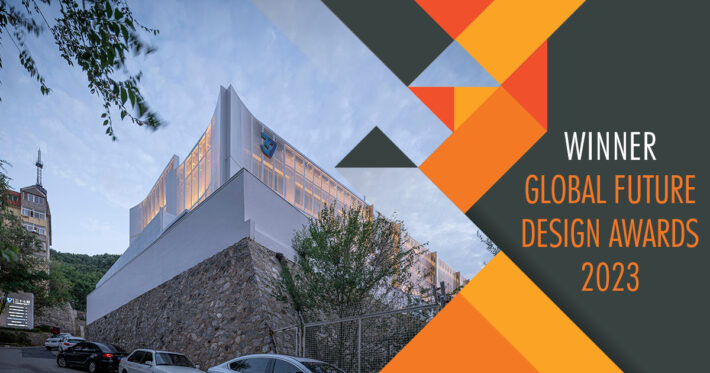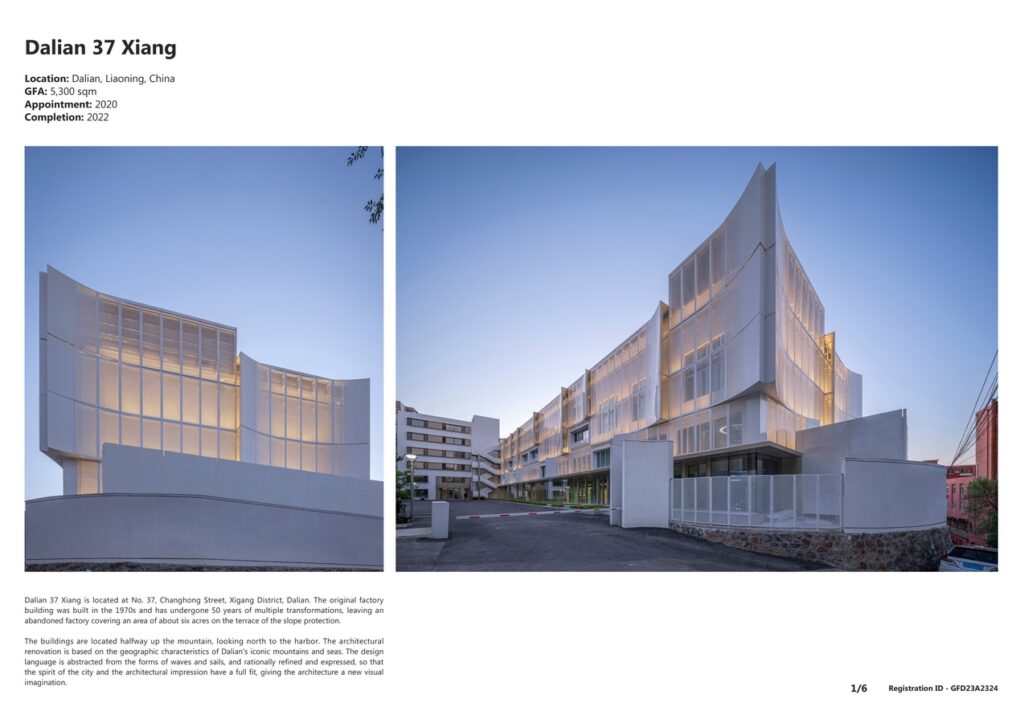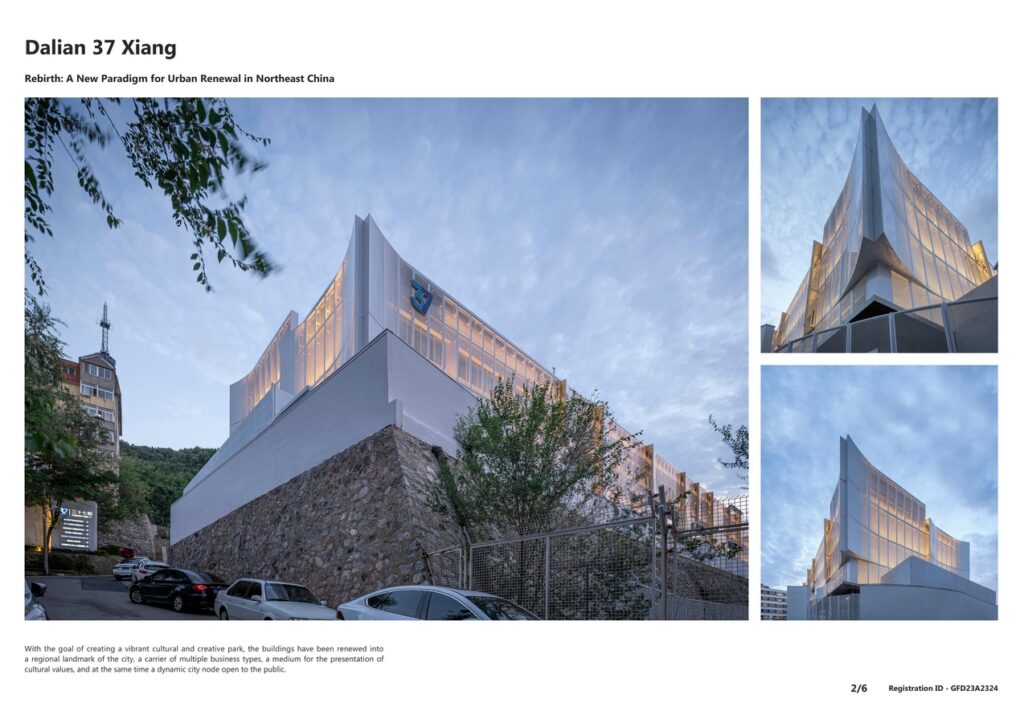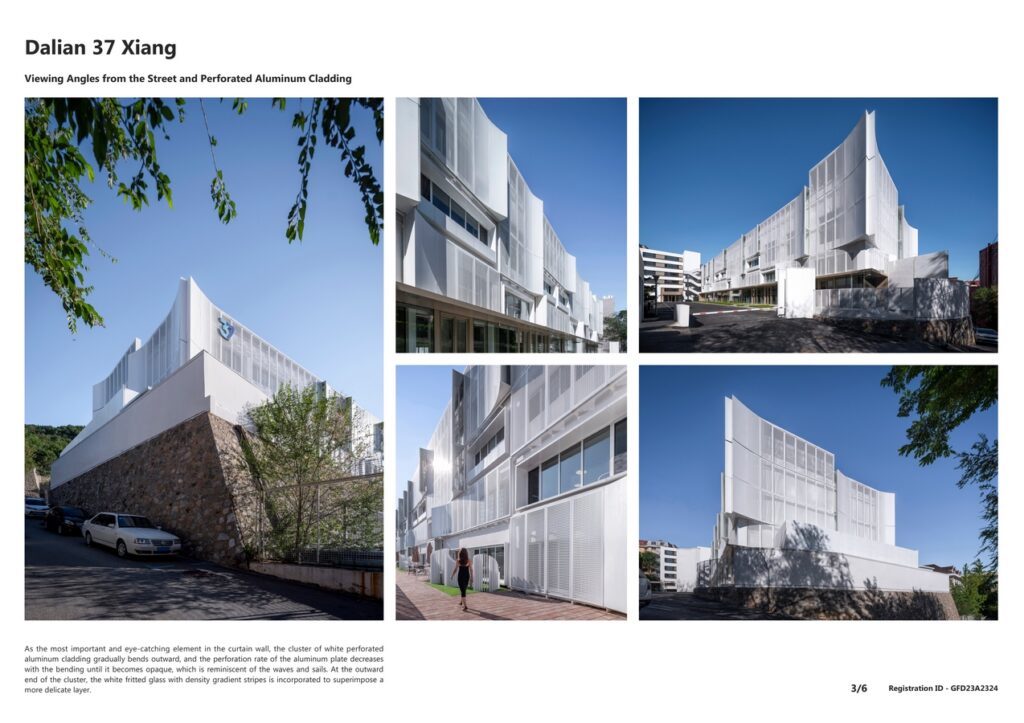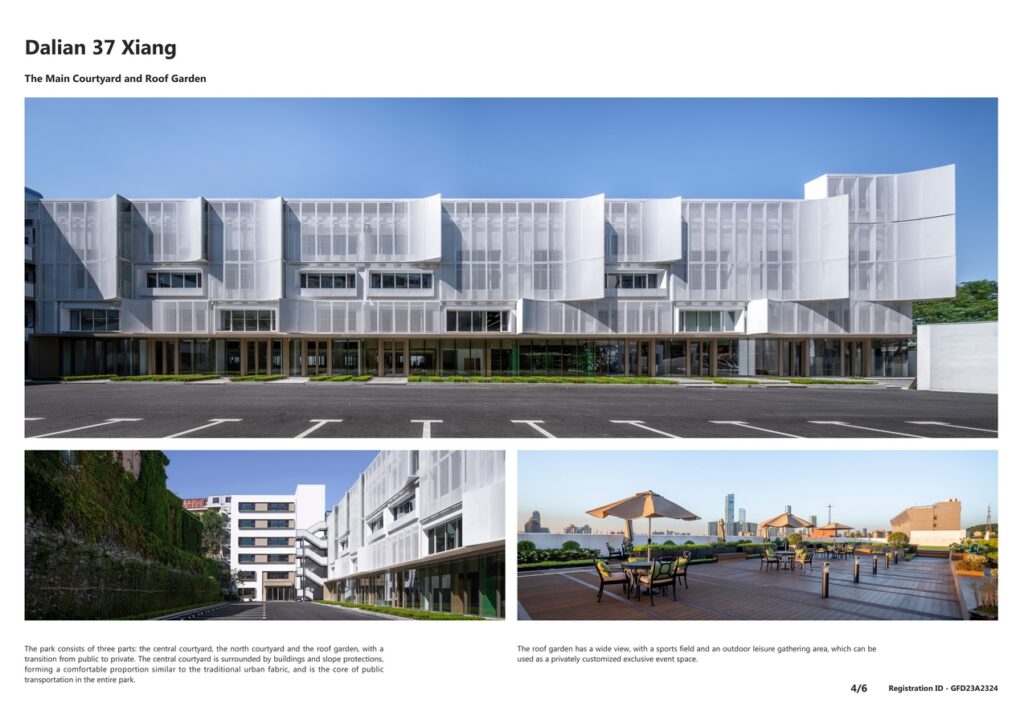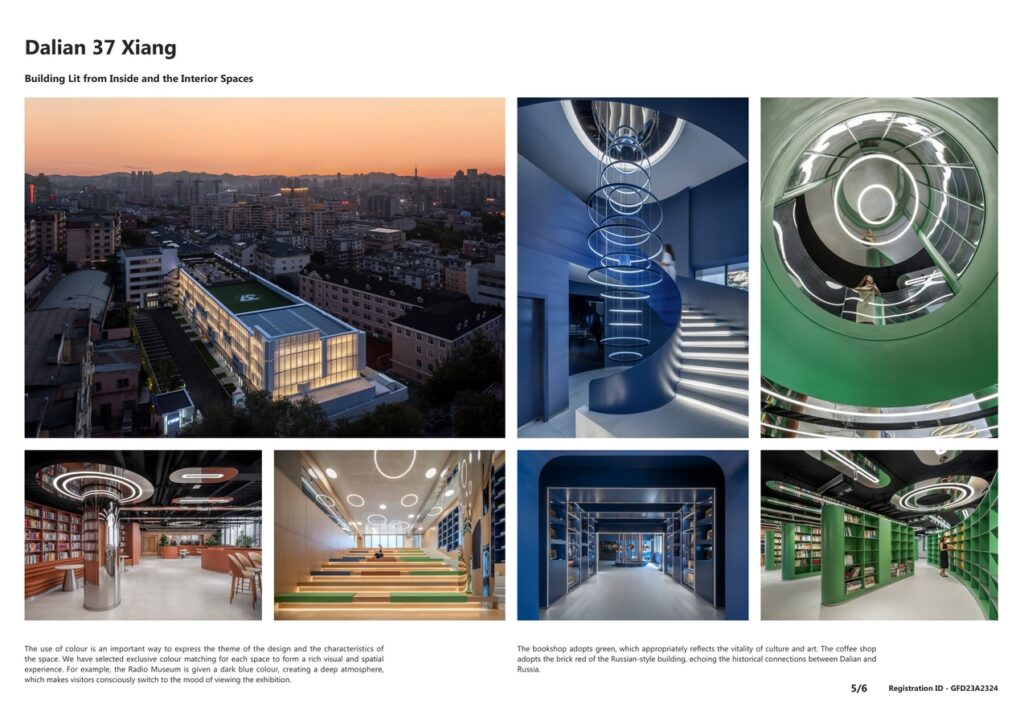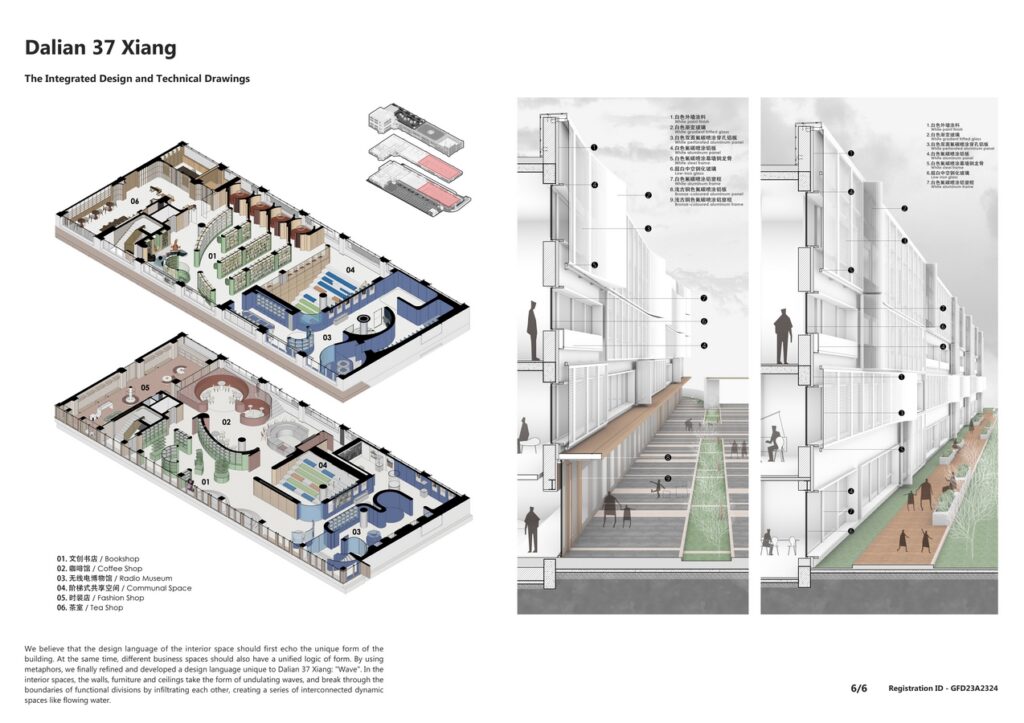Led by UUA Design Partner Yongzheng Li and Managing Partner Qizhi Li, Dalian 37 Xiang was completed in September 2022 following two years of design and construction. Transformed from an abandoned factory, the project is located in the core area of the old city of Dalian in North East China. The architectural design is inspired by the geographical features of Dalian’s iconic mountains and adjacent seas. In creating a visually striking landmark building that defines a mixed-use cultural and creative park, a new paradigm for the urban renewal of Dalian is established.
Global Future Design Awards 2024: Entries Open!
Take your work to the next level. Register Now…
Gold 🏆 Winner
Global Future Design Awards 2023
Dalian 37 Xiang
Mixed-Use Architecture (Built)
Firm
United Units Architects
Architect/Designer
Yongzheng Li
Design Team
Yongzheng Li, Qizhi Li, Liang Deng, Wenbo He, Teng Jiang, Xinghua Ma, Hongbo Fang, Yanfeng Lyu, Huanyu Chen, Jiaxin Zhang, Yuxin Jin
Project Location
Dalian . Liaoning . China
Country
China
Photographer/Copyright
©Weiqi Jin
Social Media Handles
Facebook: N/A
YouTube: N/A
Instagram: N/A
Twitter: N/A
Website URL
N/A
1.0 History: Memories of Old Industry in the 1970s
Being both a coastal city and old industrial base, Dalian shoulders the dual tasks of opening up the northeast region of China to the outside world whilst realizing the comprehensive revitalization of the old industrial base. As the economic benchmark of its region, Dalian has a large number of existing industrial heritage sites. The question is thus asked as to how best avoid extensive demolition and construction, whilst providing new functions to the old factories through proper protection and reuse. By looking to address this challenge, Dalian 37 Xiang sets a precedent for future urban renewal within this area and beyond.
Located at No. 37, Changhong Street, Xigang District, Dalian, the original factory building was built in the 1970s and has undergone 50 years of multiple transformations, leaving an abandoned factory area covering an area of about six acres on the terrace of the slope protection area. The building complex is located halfway up the mountain side with a main aspect towards the harbor in the north of the city. The redundant building remaining a reminder of the once prosperous industrial heritage of this area that drove the local economy.
2.0 Rebirth: A New Paradigm for Urban Renewal in Northeast China
“Climbing up the street, after several turns, I suddenly saw a wide building standing on the towering terrace, which was reminiscent of the Parthenon in the Acropolis. Therefore, exploring the fit between the architectural image and the city spirit has become the design origin of this project.”
—- Yongzheng Li
Located in the core area of the old city area of Dalian, the site is backed by Martyrs Mountain, facing Dalian Bay to the north, adjacent to the Dalian Government. Scattered around the site is an equally decades-old neighborhood, so over time the factory has become part of the collective memory of the local residents. Therefore, the new architectural image should not only resonate emotionally with the surrounding residents, but also become a regional landmark facing the future, activating the old community in the way of acupuncture.
The renewal of Dalian 37 Xiang introduces narrative symbols to connect history and future, adopts delicate and light intervention methods to form a contrast between the old and the new, and promotes the continuity of business by shaping the vitality of culture, creating a spiritual and pragmatic ” beacon” in the city between mountains and seas. Dalian 37 Xiang has become a new paradigm for urban renewal in the Northeast and even the whole country.
The design strategy of Dalian 37 Xiang is based on the original conditions of the site, striking a balance between sensibility and rationality. It combines multi-level emotional perception and comprehensive logical judgment to empower the renovation of the project. The key objective being to renew this old factory into a regional landmark of the city, accommodate multiple business types, and finally make it an open and dynamic city node.
The main building of the site was originally a cuboid industrial factory building with a regular 6m x 9m structural grid, presenting a typical uninspiring example of an industrial building, an impression that is essentially contradictory to the vitality of the cultural and creative industry. So how to create a continuity before and after the renovation, whilst at the same time liberating the building from the original monotonous form to achieve a more free and romantic form, is a key point of our thinking.
The first step of the renovation strategy is to establish a new facade grid. According to the client’s functional requirements, we have inserted mezzanine floors into the original 2-storey building to form a 4-storey building. The horizontal lines of the facade grid are formed according to the building levels of the floors, roof and parapet. At the same time, the vertical lines of the facade grid are spaced 1.2 meters apart, which not only conforms to the specifications of conventional building materials, but also forms a multiple relationship with the building’s structural grid. Based on this facade grid, the doors and windows of the original walls of the building were re-divided to adapt to the new architectural space layout. The keel layout and panel division of the new curtain wall system outside the original walls are also derived from this facade grid. By reorganizing the structural order contained in the original building, we established a new facade grid system superimposed on the old order. This derivative relationship between the old and the new not only fits the new curtain wall system to the old structural order, but also implies the continuity and destiny of the building within an historical dimension.
The next step was to set out the masses of the facade. Two types of facade clusters were introduced, white perforated aluminum cladding and window set. Based on the facade grid, these two clusters were arranged into a random interlaced form, transforming the original monotonous long facade into a rich visual experience of light, shadow and materials.
4.0 Symbol: The Waves Between Mountains and Seas
The emergence of the architectural image comes from the exploration of Dalian’s city spirit. Combining the unique geographical resources of mountains, hills, peninsulas, oceans, together with the urban fabric have created the impression of Dalian as a city of mountains and seas. The first inspiration for the architectural design comes from the geographical features of the city. Based on the existing mass of the building, UUA abstracts the design language from the form of waves and sails, and then through rational design development, the architectural image and the city spirit have a full fit, establishing a spiritual connection between the building and people by endowing the building with a new visual imagination.
As the most important and eye-catching element in the curtain wall, the cluster of white perforated aluminum cladding gradually bends outward, and the perforation rate of the aluminum plate decreases with the bending until it becomes opaque, which is reminiscent of the waves and sails. At the outward end of the cluster, the white fritted glass with density gradient stripes is incorporated to superimpose a more delicate layer. At the southeast corner of the building, the “waves” in two directions meet, forming the high point and visual focus of the building.
5.0 Functions: Space Reconstruction Based on Mixed Uses
Mixed business types are an important prerequisite for ensuring the vitality of the park, with each business type being suitable for a specific target customer group. Through the rational allocation and sharing of resources, different business types can guide customers to each other, creating a synergistic effect. Dalian 37 Xiang is comprised of rental offices, radio museum, coffee shop, bookshop, communal space, tea shop, fashion shop, art education, restaurant, etc., emphasizing the theme of “fusion space”.
We believe that the design language of the interior space should first echo the unique form of the building. At the same time, different business spaces should also have a unified logic of form. By using metaphors, we finally refined and developed a design language unique to Dalian 37 Xiang: “Wave”. In the interior spaces, the walls, furniture and ceilings take the form of undulating waves, and break through the boundaries of functional divisions by infiltrating each other, creating a series of interconnected dynamic spaces like flowing water.
The use of color is an important way to express the theme of the design and the characteristics of the space. We have selected exclusive color matching for each space to form a rich visual and spatial experience. For example, the Radio Museum is given a dark blue color, creating a deep atmosphere, which makes visitors consciously switch to the mood of viewing the exhibition. The bookshop adopts green, which appropriately reflects the vitality of culture and art. The coffee shop adopts the brick red of the Russian-style building, echoing the historical connections between Dalian and Russia.
6.0 Landscape: Creating a Pleasant Place to Stay
The park consists of three parts: the central courtyard, the north courtyard and the roof garden, with a transition from public to private. The central courtyard is surrounded by buildings and slope protections, forming a comfortable proportion similar to the traditional urban fabric, and is the core of public transportation in the entire park. The north courtyard is long and narrow, becoming the outdoor extension space of the shops on the ground floor, which is semi-private. The roof garden has a wide view, with a sports field and an outdoor leisure gathering area, which can be used as a privately customized exclusive event space. Looking to the north, the dense and scattered texture of the old city, the towering and fashionable skyline of the new city, as well as the bay and distant mountains that are visible between buildings, in an almost metaphorical way, reveal the Dalian 37 Xiang’s fusion of history, contemporary and nature.


